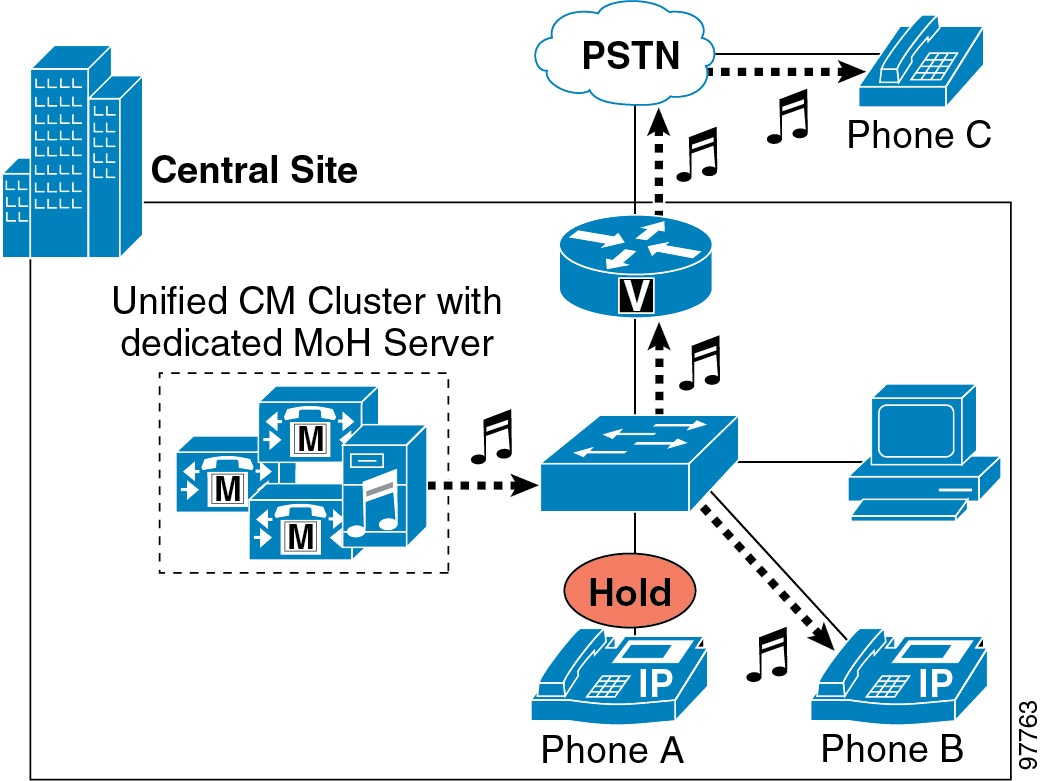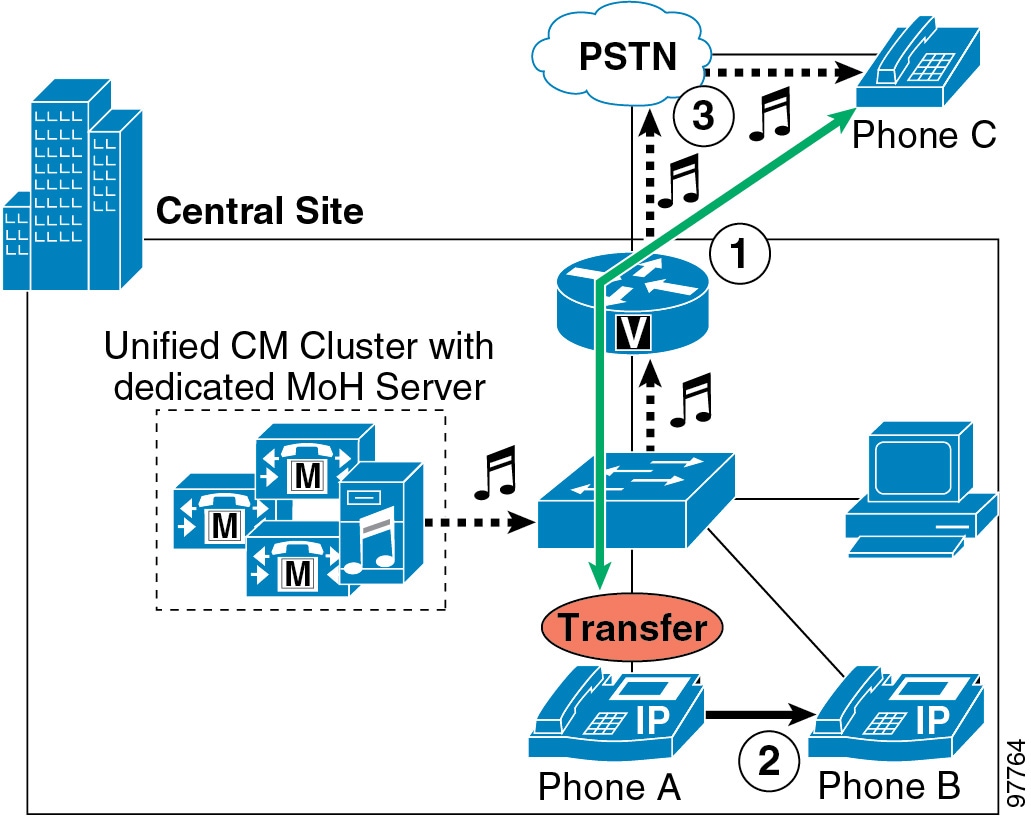- Cisco Community
- Technology and Support
- Collaboration
- IP Telephony and Phones
- MOH source is driven by phone
- Subscribe to RSS Feed
- Mark Topic as New
- Mark Topic as Read
- Float this Topic for Current User
- Bookmark
- Subscribe
- Mute
- Printer Friendly Page
- Mark as New
- Bookmark
- Subscribe
- Mute
- Subscribe to RSS Feed
- Permalink
- Report Inappropriate Content
11-21-2015 04:36 AM - edited 03-17-2019 04:59 AM
I have a doubt how the PSTN MoH works for the scenario below:
Let's I have been working with a X company with Call manager or CUCM 9 with MoH server configured MRGL1>MRG1>MoH server with Audio1, Audio 2 as source audio files mapped and applied to my phone.
Let's say I am calling ATT they are totally different network than our company and let's say ATT agent is pressed hold and I am hearing the Audio 30 from ATT call manager sourced MoH...how that gonna work in my scenario. though we never has that source file in our MRGL....Moh server how the file would still play in the case of PSTN as I am clear with the MoH concept inside the network since the MoH will send the file to another MoH...can you please guide me and also just to clarify is the MoH Audio file needs to present in the sourced MRGL > MoH preuploaded or is it a automatic process that gets copied to moh of sourced MRGL from the device....
Solved! Go to Solution.
- Labels:
-
CUCM
Accepted Solutions
- Mark as New
- Bookmark
- Subscribe
- Mute
- Subscribe to RSS Feed
- Permalink
- Report Inappropriate Content
07-11-2016 06:17 AM
Hi Nawaz,
As per the design guide:
User and Network Hold
User hold includes the following types:
- User on hold at an IP phone or other endpoint device
- User on hold at the PSTN, where MoH is streamed to the gateway
Figure 7-4 shows these two types of call flows. If phone A is in a call with phone B and phone A (holder) pushes the Hold softkey, then a music stream is sent from the MoH server to phone B (holdee). The music stream can be sent to holdees within the IP network or holdees on the PSTN, as is the case if phone A places phone C on hold. In the case of phone C, the MoH stream is sent to the voice gateway interface and converted to the appropriate format for the PSTN phone. When phone A presses the Resume softkey, the holdee (phone B or C) disconnects from the music stream and reconnects to phone A.
Figure 7-4 Basic User Hold Example

Network hold can occur in following scenarios:
Figure 7-5 illustrates an example of network hold during a call transfer. The call flow involves the following steps:
1.![]() Phone A receives a call from PSTN phone C.
Phone A receives a call from PSTN phone C.
2.![]() Phone A answers the call and then transfers it to phone B. During the transfer process, phone C is put on network hold.
Phone A answers the call and then transfers it to phone B. During the transfer process, phone C is put on network hold.
3.![]() Phone C receives an MoH stream from the MoH server via the gateway. After phone A completes the transfer action, phone C disconnects from the music stream and gets redirected to phone B.
Phone C receives an MoH stream from the MoH server via the gateway. After phone A completes the transfer action, phone C disconnects from the music stream and gets redirected to phone B.
This process is the same for other network hold operations such as call park and conference setup.

http://www.cisco.com/c/en/us/td/docs/voice_ip_comm/cucm/srnd/collab11/collab11/media.html#81742
HTH
Manish
- Mark as New
- Bookmark
- Subscribe
- Mute
- Subscribe to RSS Feed
- Permalink
- Report Inappropriate Content
11-21-2015 06:59 AM
- Mark as New
- Bookmark
- Subscribe
- Mute
- Subscribe to RSS Feed
- Permalink
- Report Inappropriate Content
07-11-2016 03:51 AM
The question is not about the PSTN phone pressing the hold...my question is if the Company A(VOIP) phone is internal employee presses hold to to the PSTN phone B...
then Company A is selecting the Audio file to multicast right...through MoH...then how PSTN phone will listen this file when the PSTN phone never has this file in the other end....
since this concept internally works fine since the phone A(internal) and phone B internal(B both MoH server should have the file to listen too...correct
My question is since gateway is involved and PSTN is no where in control does that mean that PSTN audio(MoH) is sent through the gw.....like normal audio through B channel...the internal concept says that both the MoH holder and holdee needs to have the MoH audio file in the server to listen or play if not it won't play the file rather plays the silence/tone on hold...
I have music A uploaded to MoH server internally and it means if I press the hold button during the call the other party on the other side should listen to the music A always...
So, if the other side is PSTN....how the music A will be played to the PSTN person...like normal audio through GW
- Mark as New
- Bookmark
- Subscribe
- Mute
- Subscribe to RSS Feed
- Permalink
- Report Inappropriate Content
07-11-2016 06:17 AM
Hi Nawaz,
As per the design guide:
User and Network Hold
User hold includes the following types:
- User on hold at an IP phone or other endpoint device
- User on hold at the PSTN, where MoH is streamed to the gateway
Figure 7-4 shows these two types of call flows. If phone A is in a call with phone B and phone A (holder) pushes the Hold softkey, then a music stream is sent from the MoH server to phone B (holdee). The music stream can be sent to holdees within the IP network or holdees on the PSTN, as is the case if phone A places phone C on hold. In the case of phone C, the MoH stream is sent to the voice gateway interface and converted to the appropriate format for the PSTN phone. When phone A presses the Resume softkey, the holdee (phone B or C) disconnects from the music stream and reconnects to phone A.
Figure 7-4 Basic User Hold Example

Network hold can occur in following scenarios:
Figure 7-5 illustrates an example of network hold during a call transfer. The call flow involves the following steps:
1.![]() Phone A receives a call from PSTN phone C.
Phone A receives a call from PSTN phone C.
2.![]() Phone A answers the call and then transfers it to phone B. During the transfer process, phone C is put on network hold.
Phone A answers the call and then transfers it to phone B. During the transfer process, phone C is put on network hold.
3.![]() Phone C receives an MoH stream from the MoH server via the gateway. After phone A completes the transfer action, phone C disconnects from the music stream and gets redirected to phone B.
Phone C receives an MoH stream from the MoH server via the gateway. After phone A completes the transfer action, phone C disconnects from the music stream and gets redirected to phone B.
This process is the same for other network hold operations such as call park and conference setup.

http://www.cisco.com/c/en/us/td/docs/voice_ip_comm/cucm/srnd/collab11/collab11/media.html#81742
HTH
Manish
- Mark as New
- Bookmark
- Subscribe
- Mute
- Subscribe to RSS Feed
- Permalink
- Report Inappropriate Content
11-23-2015 02:05 AM
Well explained Chris.. Adding more information related to MOH.
MoH is played to a caller when the remote party in the call puts the caller on hold. MoH
requires an MoH server to be configured and an audio file that will be played during
the hold event.
When multicast support is enabled, the multicast stream can increase, based on port number or IP address.
For the MoH audio source, additional audio files can be added to the MoH server. Endpoints/devices can be configured to play different audio files as required. An MoH audio source file can be assigned as User Hold Audio Source and/or Network Hold Audio
Source to the phones. If an audio source file is defined at the device level, it overrides the device pool audio source preference. To upload an MoH audio file (the file must first be uploaded to the CUCM that is functioning as the MoH server), go to the Cisco Unified
CM Administration page and choose Media Resources > Music on Hold Audio Source , click Add New > Upload File , select an audio file you wish to upload as the MoH file, and click Upload .
Media Resource Group and Media Resource Group List
After media resources are defined, they need to be managed and assigned to intended devices/endpoints/device pools. Refer the urls
http://www.cisco.com/c/en/us/td/docs/voice_ip_comm/cucm/srnd/collab10/collab10/media.html#81742
http://www.cisco.com/c/en/us/td/docs/voice_ip_comm/cucm/srnd/collab10/collab10/media.html#pgfId-1153876
Regards
Lavanya
- Mark as New
- Bookmark
- Subscribe
- Mute
- Subscribe to RSS Feed
- Permalink
- Report Inappropriate Content
11-23-2015 04:53 AM
@Chris can you tell me which page of the Cisco SRND talks about the PSTN MoH in detail since its 1K page please provide the page information...
@Muthurani I know how the MoH works but not about the PSTN..no need to give additinal information...
- Mark as New
- Bookmark
- Subscribe
- Mute
- Subscribe to RSS Feed
- Permalink
- Report Inappropriate Content
11-23-2015 05:53 AM
http://www.cisco.com/c/en/us/td/docs/voice_ip_comm/cucm/srnd/collab11/collab11/media.html#pgfId-1153848
Let us know if you have further questions. Don't forget to rate all useful posts!
Chris
Discover and save your favorite ideas. Come back to expert answers, step-by-step guides, recent topics, and more.
New here? Get started with these tips. How to use Community New member guide


